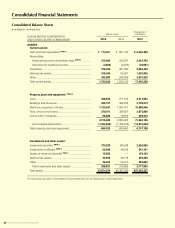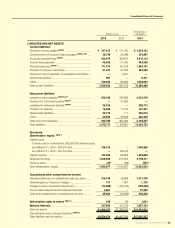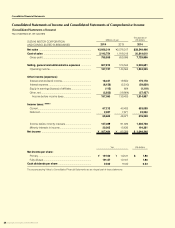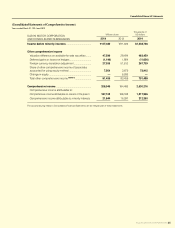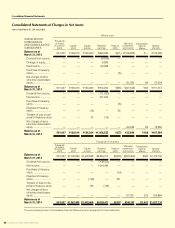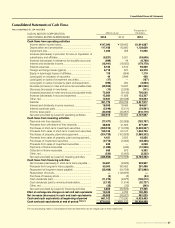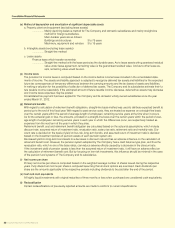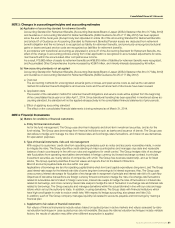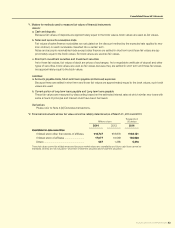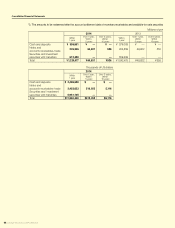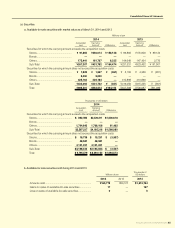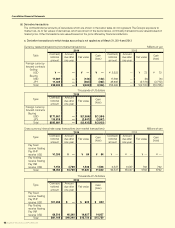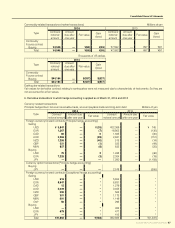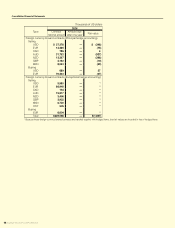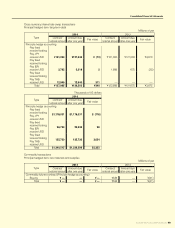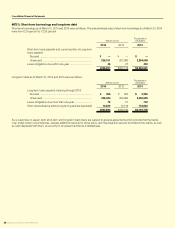Suzuki 2014 Annual Report Download - page 43
Download and view the complete annual report
Please find page 43 of the 2014 Suzuki annual report below. You can navigate through the pages in the report by either clicking on the pages listed below, or by using the keyword search tool below to find specific information within the annual report.
Consolidated Financial Statements
SUZUKI MOTOR CORPORATION 41
NOTE 3: Changes in accounting principles and accounting estimates
(a)Applicationofaccountingstandardforretirementbenets
Accounting Standard for Retirement Benets (Accounting Standards Board of Japan (ASBJ) Statement No.26 of 17 May 2012)
and Guidance on Accounting Standard for Retirement Benets (ASBJ Guidance No.25 of 17 May 2012) has been applied
since the end of this scal year. (Except body text stipulated in article 35 of the Accounting Standard for Retirement Benets
and article 67 of Guidance on Accounting Standard for Retirement Benets) Pension assets are deducted from retirement
benet obligation and the net amount is recognized as liability for retirement benets, and previously unrecognized actuarial
gains or losses and past service costs are recognized as liabilities for retirement benets.
In accordance with transitional accounting as stipulated in article 37 of the Accounting Standard for Retirement Benets, the
effect of the change in accounting policies arising from initial application is recognized in accumulated adjustments for retire-
ment benet within the accumulated other comprehensive income.
As a result, ¥15,862 million of assets for retirement benets and ¥36,918 million of liabilities for retirement benets were recognized,
and Accumulated Other Comprehensive Income increased by ¥3,867 million, and minority interests decreased by ¥6 million.
(b) New accounting standards not yet applied
Accounting Standard for Retirement Benets (Accounting Standards Board of Japan (ASBJ) Statement No.26 of 17 May 2012)
and Guidance on Accounting Standard for Retirement Benets (ASBJ Guidance No.25 of 17 May 2012)
a. Overview
The accounting methods for unrecognized actuarial gains or losses and past service costs as well as the calculation
method for retirement benet obligations and service costs and the enhancement of disclosure have been revised.
b. Application date
The revision of the calculation method for retirement benet obligations and service costs will be applied from the beginning
of the consolidated scal year on or after April 1, 2014. Since transitional handling has been specied in mentioned above ac-
counting standard, the standard will not be applied retrospectively to the consolidated nancial statements of prior periods.
c. Effect of applying accounting standard
The effect on the consolidated nancial statements is being reviewed as of March 31, 2014.
NOTE 4: Financial Instruments
(a) Mattersforconditionsofnancialinstruments
a.Policyfornancialinstruments
As for the fund management, The Group uses short-term deposits and short-term investment securities, and as for the
fund-raising, The Group uses borrowings from nancial institutions such as banks and issuance of bonds. The Group uses
derivatives to hedge and manage the risks of interest-rates and exchange-rates uctuations, and does not use derivatives
for speculation purposes.
b.Typeofnancialinstruments,risksandriskmanagement
With respect to customers’ credit risks from operating receivables such as notes and accounts receivables-trade, in order
to mitigate the risks, The Group identies credit standing of major counterparties and manages due date and receivable
balance of each counterparty in line with our rules and regulations for credit control. The Group hedges risks of exchange-
rate uctuations from operating receivables denominated in foreign currency by forward exchange contract in principle.
Investment securities are mainly stocks of companies with which The Group has business relationship, and as for listed
stocks, The Group quarterly identies those fair values and reports them to the Board of Directors.
Most of accounts payable-trade are due within one year.
Applications of borrowings are fund for operating capital (mainly short-term) and capital expenditures (long-term), and The Group
uses interest-rate swaps for the interest rate risks of some long-term borrowings to x interest expenses. Also, The Group uses
cross currency interest rate swaps for uctuation of exchange rate in repayment of principle and interest rate risk to x cash ow.
Objectives of derivative transactions are foreign currency forward contracts to hedge the risks of exchange-rate uctuations
related to receivables denominated in foreign currencies, interest rate swaps to hedge the risks of uctuations in interest rate
related to borrowings, and cross currency interest rate swaps to hedge the risk of uctuation in exchange rate and interest rate
related to borrowings. The Group executes and manages derivatives within the actual demand in line with our rules and regu-
lations which set out the authority to trade. In addition, in using derivatives, The Group deals with nancial institutions which
have high credit grade in order to reduce credit risks. With respect to hedge accounting, also please see Note 2 (l).
In addition, each of The Group company manages liquidity risk related to accounts payable and borrowings by making a
nancial plan.
c.Supplementtofairvaluesofnancialinstruments
Fair values of nancial instruments include values based on quoted prices in active markets and values assessed by ratio-
nal valuation techniques in case quoted prices are not available. Because the rational valuation techniques include variable
factors, the results of valuation may differ when different assumption is applied.



